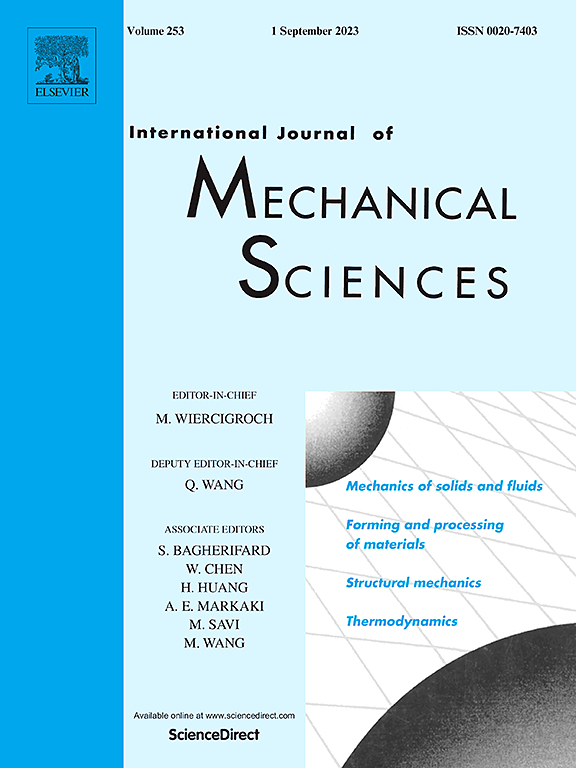Micro-mechanism of mechanical enhancement of NiTiAl amorphous-crystal nanomultilayers
IF 7.1
1区 工程技术
Q1 ENGINEERING, MECHANICAL
International Journal of Mechanical Sciences
Pub Date : 2025-02-04
DOI:10.1016/j.ijmecsci.2025.110020
引用次数: 0
Abstract
Amorphous-crystal nanomultilayers (ACNMs) exhibit outstanding mechanical properties, but the micro-mechanisms responsible for the enhancement of their mechanical performance remain incompletely understood. Molecular dynamics (MD) simulations were performed on the tensile processes of NiTiAl ACNMs to examine the microstructure evolutions during deformation in crystals, amorphous (MGs), and crystal-amorphous interfaces (CAIs). ACNMs increase in strength and decrease in plasticity with decreasing interface spacing. The MGs layer can accommodate larger strains. The intense competition among shear transformation zones (STZs) mitigates strain localization in MGs and boosts the plasticity of ACNMs. In the crystal layer, the main plastic deformation mechanism is that FCC clusters are disrupted and converted into other MGs clusters. As the interface spacing decreases, the geometrically constrained dispersion of STZs boosts material strength. The self-developed Largest Standard Cluster Analysis (LaSCA) method was employed to accurately depict the microstructure evolution of CAIs. The CAIs are responsible for strain transmission and induce dislocation accumulation in their vicinity, leading to localized strain. This study elucidates the microstructural changes in ACNMs during tensile deformation, offering insights for optimizing their mechanical properties through interface spacing design.

求助全文
约1分钟内获得全文
求助全文
来源期刊

International Journal of Mechanical Sciences
工程技术-工程:机械
CiteScore
12.80
自引率
17.80%
发文量
769
审稿时长
19 days
期刊介绍:
The International Journal of Mechanical Sciences (IJMS) serves as a global platform for the publication and dissemination of original research that contributes to a deeper scientific understanding of the fundamental disciplines within mechanical, civil, and material engineering.
The primary focus of IJMS is to showcase innovative and ground-breaking work that utilizes analytical and computational modeling techniques, such as Finite Element Method (FEM), Boundary Element Method (BEM), and mesh-free methods, among others. These modeling methods are applied to diverse fields including rigid-body mechanics (e.g., dynamics, vibration, stability), structural mechanics, metal forming, advanced materials (e.g., metals, composites, cellular, smart) behavior and applications, impact mechanics, strain localization, and other nonlinear effects (e.g., large deflections, plasticity, fracture).
Additionally, IJMS covers the realms of fluid mechanics (both external and internal flows), tribology, thermodynamics, and materials processing. These subjects collectively form the core of the journal's content.
In summary, IJMS provides a prestigious platform for researchers to present their original contributions, shedding light on analytical and computational modeling methods in various areas of mechanical engineering, as well as exploring the behavior and application of advanced materials, fluid mechanics, thermodynamics, and materials processing.
 求助内容:
求助内容: 应助结果提醒方式:
应助结果提醒方式:


